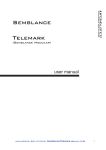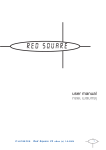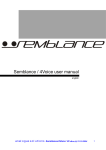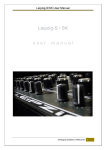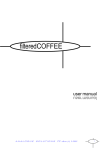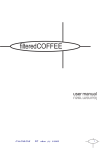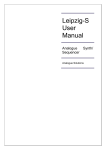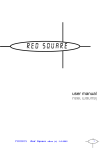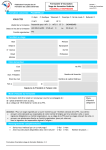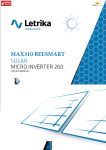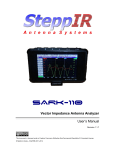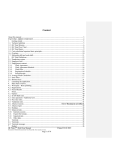Download User Manual - Junostatic.com
Transcript
User Manual Contents Introduction...................................................................................................................................................... 3 Brief Overview .................................................................................................................................................. 3 Applications ...................................................................................................................................................... 3 Safety Instructions ............................................................................................................................................ 4 Initial Tuning ..................................................................................................................................................... 5 Circuit in Details................................................................................................................................................ 5 Voltage Controlled Oscillators VCO 1 ............................................................................................................... 6 Voltage Controlled Oscillators VCO 2 ............................................................................................................... 7 Sync .................................................................................................................................................................. 8 Mixer ................................................................................................................................................................ 8 Voltage Controlled Filter VCF ........................................................................................................................... 9 Filtering External Sound Sources .................................................................................................................... 10 Envelope Generators ...................................................................................................................................... 11 Voltage Controlled Amplifier - VCA ................................................................................................................ 12 Low Frequency Oscillator - LFO ...................................................................................................................... 12 Pitch Bend and Mod Wheel ............................................................................................................................ 13 Rear Panel Audio Connections........................................................................................................................ 14 CV/Gate Jacks ................................................................................................................................................. 15 Patch Panel ..................................................................................................................................................... 15 No Signal? ....................................................................................................................................................... 16 Quick method for zero modulation ................................................................................................................ 16 Expansion ....................................................................................................................................................... 16 Internal Calibration of internal VCOs .............................................................................................................. 17 MIDI Data Editing ........................................................................................................................................... 18 Parameters and Pages in More Detail ............................................................................................................ 19 Specification ................................................................................................................................................... 20 Warranty ........................................................................................................................................................ 21 Analogue Solution – Telemark-k – 2012 2|P age Introduction Congratulations on buying the Telemark synthesiser. Telemark is part of the Analogue Solutions range of analogue music equipment. Telemark is a precision electronic musical instrument. It combines all the often needed music electronic circuitry to make a music synthesiser in one compact module. No compromise has been made with the construction of Telemark. Cheaper options in parts have not been used Full rugged steel case - no plastic mouldings Good quality smooth potentiometers, fully sealed against dust Good quality knobs with spun aluminium caps High grade double sided circuit board All power and signal input/outputs have EM filters to remove external noise and improve immunity High Quality DAC - 16bit! (others use 12 or even 8 bit) Very stable MIDI to CV conversion Very stable analogue oscillators Expensive blue Hand built by humans Lasting quality and appeal with a life far longer than any software plug-in or DSP synth Brief Overview Telemark is a self-contained TRUE analogue synthesiser. The voice circuitry is entirely analogue, using all discrete and op-amp components. There is no voice DSP happening! Telemark has a similar sound and specification to the classic Oberheim SEM, but with many improvements such as MIDI, Noise, more modulation. Note however, Telemark is not intended to be and is not a clone of the SEM. If you want a true SEM sound, buy a SEM! Applications MONO SYNTHESISER Telemark is for use any time you need analogue sound effects, fat basses, screaming leads, beeps, tones, zaps, and all the other crazy sounds associated with analogue synthesis. Use in place of your boring digital synths and DSP soft synths. EFFECTS PROCESSOR Telemark has an audio input socket, so you can feed external sounds into the on-board analogue filters for analogue processing. Analogue Solution – Telemark-k – 2012 3|P age Safety Instructions Please read carefully before using: Only use the correct power adaptor - 230V (or 115V whatever your country needs) Never handle the adaptor with wet hands Never excessivly bend the adaptor cable or get it trapped or place heavy objects on it. If the adaptor cable becomes damaged, replace the adaptor. Ensure the unit is disconnected from the mains before moving or cleaning. Always disconnect the unit from the mains if there is lightning in your area. Ensure the unit is on a stable surface, and never place heavy objects on top of it. Never allow young children or animals to operate the unit or adaptor. Do not use excessive force when using the controls or inserting cables to the connectors. The unit should not be operated in the rain or near water and should not be exposed to moisture. If the unit is brought from a cold environment to a warm one, the unit should be left to reach the ambient temperature. Keep Telemark away from heat sources, such as radiators, ovens, heaters etc. Never allow Telemark to get wet. Do not operate it near water, like pools, sinks, bathrooms etc. Do not place beverages on or near it. Never open the case or attempt to make repairs. Refer any servicing to qualified service personnel. Preventing damage to other connected devices; Telemark has a very high dynamic range. It is capable of produce loud signals of very high and sub-sonic frequencies that could blow inadequate speakers if played too loud. It is recommended that input levels to external equipment (mixers, amp's etc.) is kept low when first connected, and then slowly increased to a useable level. Maintenance Instructions Any cleaning of the Telemark case should be done with a clean lint-free cloth. DO NOT USE SOLVENTS OR CLEANERS, as this will deteriorate the exterior appearance of the equipment. Mounting Mounting does not mean 'place on the wall' or 'to make love to' in this instance. Place Telemark soundly on any stable surface so he cannot fall off or over, causing it or your- self injury. POWER Possible sources of US voltage mains adaptors (not tested); www.radioshack.com p/n 273-1631 or 273-1690 Analogue Solution – Telemark-k – 2012 4|P age Initial Tuning Once the MIDI and audio connections have been made it may be necessary to tune in the VCOs to the rest of your music set-up. Allow a five minute warm up time. First set up the controls of Telemark to make a simple sound. It is usually best to leave the VCA at ON. Turn VCO2 to zero volume so you can only hear VCO1. Play, say middle C on the keyboard. Using a digital keyboard as a reference, adjust the course or fine tuning of VCO1 until it plays in tune with your reference. Finally, turn up VCO2 so both VCOs can be heard. Using the tune controls of VCO2, tune it to VCO1. Circuit in Details Here follows details on all the sockets and controls, with brief simplified explanations of what the circuits do. We have not gone into technical details on how and exactly what each circuit does but tried to explain each control's function and effect. Anyone who has used synthesisers before should be familiar with the terms used and therefore be able to predict their behaviour and how they affect the sound. The best way to learn how to use Telemark is to go straight ahead and play with it. Reading of this manual may only be necessary for finer operational detail. Analogue Solution – Telemark-k – 2012 5|P age Voltage Controlled Oscillators VCO 1 The voltage controlled oscillators (VCOs 1 and 2) produce the raw audio waveform usually used as the initial source for sound creation. They provide cyclic audio waveforms that can be pitched. VCOs usually receive treatment from the VCF to turn their basic tones into pleasant sounds. FINE TUNE: Controls fine pitch adjustment of VCO1. Use this to tune VCO1 to your other instruments or VCO2. TUNE: Controls the course pitch of VCO1. Range is about +/- 2 octaves. Use this to tune VCO1 to your other instruments or to shift the VCO pitch up or down an octave compared to VC02 MODULATION: This controls the amount of modulation to either pulse width or pitch from the modulation source selected by the SOURCE switch. Turn this knob clockwise in increasing amounts to apply pulse width modulation (PWM) to the square wave. This will have the effect of thickening up the VCO sound. Extreme settings of modulation may result in the sound cutting out.. Turn this knob anti-clockwise in increasing amounts to apply frequency modulation (FM) to VCO1. Use this for vibrato and trill effects on the pitch. In a central position, there will be no modulation to either PW or Frequency MODULATION SOURCE rotary switch: This selects the modulation source for either PWM or FM and is routed to the control above. The source options are; EG2 for pitch sweeps. Good for percussion sounds EXT2 for sound effects and additional modulation LFO for vibrato and trill effects VCO1 Square wave for frequency modulation effects PULSE WIDTH: This control allows manual shaping of the pulse wave output. It alters the pulse width (duty cycle) of the pulse wave. In a central position a square wave is produced (50% duty cycle). Try this control and listen to how the tone of the waveform changes. When using Pulse Width Modulation, it is best to set the Pulse Width control to centre, otherwise the sound may cut-out. Analogue Solution – Telemark-k – 2012 6|P age Voltage Controlled Oscillators VCO 2 The voltage controlled oscillators (VCOs 1 and 2) produce the raw audio waveform usually used as the initial source for sound creation. They provide cyclic audio waveforms that can be pitched. VCOs usually receive treatment from the VCF to turn their basic tones into pleasant sounds. FINE TUNE: Controls fine pitch adjustment of VCO2. Use this to tune VCO1 to your other instruments or VCO1. TUNE: Controls the course pitch of VCO1. Range is about +/2 octaves. Use this to tune VCO2 to your other instruments or to shift the VCO pitch up or down an octave compared to VC01 MODULATION: This controls the amount of modulation to either pulse width or pitch from the modulation source selected by the SOURCE switch. Turn this knob clockwise in increasing amounts to apply pulse width modulation (PWM) to the square wave. This will have the effect of thickening up the VCO sound. Extreme settings of modulation may result in the sound cutting out.. Turn this knob anti-clockwise in increasing amounts to apply frequency modulation (FM) to VCO2. Use this for vibrato and trill effects on the pitch. In a central position, there will be no modulation to either PW or Frequency MODULATION SOURCE rotary switch: This selects the modulation source for either PWM or FM and is routed to the control above. The source options are; EG2 for pitch sweeps. Good for percussion sounds EXT2 for sound effects and additional modulation LFO for vibrato and trill effects VCO1 Square wave for frequency modulation effects PULSE WIDTH: This control allows manual shaping of the pulse wave output. It alters the pulse width (duty cycle) of the pulse wave. In a central position a square wave is produced (50% duty cycle). Try this control and listen to how the tone of the waveform changes. When using Pulse Width Modulation, it is best to set the Pulse Width control to centre, otherwise the sound may cut-out. Analogue Solution – Telemark-k – 2012 7|P age Sync SYNC Switch: This switch selects the routings for oscillator sync. The options are: 1>2 LFO>2 OFF 2>1 VCO2 slaved to VCO1 VCO2 slaved to LFO off no sync effect VCO1 slaved to VCO2 Oscillator sync is where the master signal will reset the waveform of the slave signal each time the master waveform starts a new cycle. Try the different settings and listen to their effect. You may have to modulate the pitch of either VCO1 or VCO2 to enhance the effect. There is a balancing act between the pitch of the two sound sources (usually the 2 VCOs) to get a good effect, once found you'll know you've found it! Mixer The mixer is used to bring various audio source signals together for filtering. There are 3 mixer controls. NOISE GENERATOR: The noise generator produces white noise. This is like the hiss you hear between radio stations. The signal is available for filtering via the Noise/EXT4 mixer control. Noise would be used for sound effects such as breath, wind, percussion, etc Saw/Pulse VCO1 level Turning the control clockwise in increasing amounts sends VCO1s pulse signal to the mixer. Turning the control anti-clockwise in increasing amounts sends VCO1s sawtooth wave signal to the mixer. In a central position no signal is sent from VCO1 to the mixer. Saw/Pulse VCO2 level Turning the control clockwise in increasing amounts sends VCO2s pulse wave signal to the mixer. Turning the control anti-clockwise in increasing amounts sends VCO2s sawtooth wave signal to the mixer. In a central position no signal is sent from VCO2 to the mixer. Noise/EXT4 Level Turning the control clockwise in increasing amounts sends the signal (if any) coming in off the rear panel EXT4 socket to the mixer.Turning the control anti-clockwise in increasing amounts sends white Noise to the mixer. In a central position no signal is sent from the Noise generator or EXT4 to the mixer. Analogue Solution – Telemark-k – 2012 8|P age Voltage Controlled Filter VCF The voltage controlled filter (VCF) is used to alter the tone of the VCOs/Noise and is the heart of what gives an analogue synth its character. There are 4 types of filter available; Low Pass High Pass Band Pass Notch Pass (variable between Low/High) - Frequency This sets the cut-off frequency, the point at which the VCF will start to filter-out harmonics. - Resonance Resonance is a feature of adding feedback to the filter circuit. The output of the filter is fed back into the filter input. Resonance sets the level of feedback. As the control is increased to higher levels the filter will self-oscillate. The oscillation frequency is set by the frequency control. Use Resonance to alter the tone of the filter effect. It can be used to create squidgy sounds and pulse hits - Modulation Amount Turning the control clockwise will increase the amount that the modulation source selected by the MOD.SOURCE switch (outlined below) will modulate the cut-off frequency. Turning the control anti-clockwise works just like clockwise except that the modulation signal is inverted (negative). In a central position the selected modulation source will not affect cut-off modulation. - MOD SOURCE rotary switch This selects the modulation source that will affect the filter cut-off and is routed to the control above. There are 4 modulation sources; EG1 EG1 is used as a modulation source. Use for tonal changes. LFO LFO is used as a modulation source. Use for filter sweeps (wah-wah). - Notch VCO2 This sets the relative mix between the low pass and high pass filters that is fed to the Filter Type selection switch (6) Notch position. Pulse wave of VCO2 is used as a modulation source. Use for effects. EXT2 Signal at the EXT2 socket is used as a mod source. Use for external filter control. Cont… Analogue Solution – Telemark-k – 2012 9|P age - Filter Type rotary switch - CV1/2 MODULATION amount This selects the modulation source that will affect the filter cut-off Turning the control clockwise will increase the amount that CV2 (MIDI controller/ velocity) will modulate the cut-off frequency. LP Low Pass: signals above the cut-off frequency are attenuated 12dB/octave BP Band Pass: signals above and below the cut-off frequency are attenuated 12dB/ octave. HP High Pass: signals below the cut-off frequency are attenuated 12dB/octave. Notch Notch: signals at the cut-off frequency are attenuated 12dB/octave Turning the control anti-clockwise will increase the amount that CV1 (MIDI note/pitch) will modulate the cut-off frequency. In a central position CV1 and CV2 will not affect cut-off modulation Filtering External Sound Sources External sound sources, such as vocals, guitars, mixer sends, samplers, etc. can be sent through the filter for extra treatment. Note, mic's and guitars may need pre-amping use if the signal is too quiet. Simply plug the sound source into the rear panel EXT1 socket. Turn the mixer control Noise/EXT1 to EXT1, and up to a suitable level. You may wish to return the VCO1 and VCO2 mixer controls to their centre positions so the VCOs cannot be heard. Turn the VCA mode switch to ON. This will leave the VCA open so a constant signal can be heard. Finally, play around with the filter and modulation settings as neccessary. The VCO signals can also be introduced, and use the various VCA modes and envelopes if you wish to contour the sound level and add additional effects. Analogue Solution – Telemark-k – 2012 10 | P a g e Envelope Generators EG1 ASR EG1 ASR EG1 is an ASR (attack / sustain / release) envelope generator. Use it to modulate various parameters of the synthesiser. EG1 is generally assigned for use with modulating VCO1 and the filter cut-off. EG2 is just the same as EG1. EG2 is generally assigned for use with modulating VCO2 and the VCA. ATTACK Controls the Attack time. This is the rate at which the envelope signal will take to reach full level when the MIDI note/key pressed. ATTACK Controls the Attack time. This is the rate at which the envelope signal will take to reach full level when the MIDI note/key pressed. DECAY DECAY Controls the Decay or the Release time - the time it take the envelope signal to return to zero when the key is released. Controls the Decay or the Release time - the time it take the envelope signal to return to zero when the key is released. SUSTAIN SUSTAIN Controls the level the envelope will hold at when a key is pressed and the attack cycle has completed. Controls the level the envelope will hold at when a key is pressed and the attack cycle has completed. Analogue Solution – Telemark-k – 2012 11 | P a g e Voltage Controlled Amplifier - VCA The Voltage Controlled Amplifier (VCA) is the circuit that is used to change the output volume. Normally an envelope signal would be used to do this, so the sound starts loud then gradually fades away. The filter audio output is hardwired to the VCA signal input. VOLUME - This sets the output level of Telemark, i.e. the output from the VCA that is sent to the SIGNAL output socket MODE – Rotary Switch The VCA can be controlled in 4 modes EG2 When EG2 is selected, the envelope signal of EG2 is used to modulate the VCA level. Use it if you require the VCA level to change over time. (Normal use). MIDI/EG When this is selected, EG2 is again used as the modulation source, but the overall envelope level is in turn controlled by CV2 (MIDI) This allows velocity / controller dynamics to change the volume. If CV2 source is MIDI volume (controller 7) then MIDI volume changes can be realised. GATE When GATE is selected, the MIDI note on/off information is used to modulate the VCA. With this, the VCA level is either off or full on. The audio envelope would be like an organ's, with no attack or decay time. ON When ON is selected, the VCA is left permanently on at full level. Use this setting if you wish to use the Filter as an effects processor, to process external audio fed into Telemark via the EXT1 socket. Low Frequency Oscillator - LFO The Low Frequency Oscillator (LFO) is basically identical to a VCO; it is another oscillator, except that it produces periodic wave forms of low frequency, typically sub-audio. These slow cyclic waveforms are used for modulating other circuit parameters, for example, for sweeping the filter cut-off up and down, either slowly for a nice sweep, or faster for a 'wah-wah' type effect. It could be used to modulate the VCO pitch for vibrato. The LFO block is grouped together with the VCOs as an LFO is an oscillator just like the VCOs are. SPEED – This sets the frequency (speed) of the LFO which is indicated by the LED MODE – This sets the modulation source that is routed to LFO points for modulation selection. The options are: SQUARE WAVE MIDI Control (CV2) TRIANGLE WAVE SAMPLE and HOLD* *Sample and Hold (S+H) is a flash term that in this instance basically means a modulation is created that has a new random signal level each time the LFO completes a cycle (each time the LFO LED lights up a new modulation level is set) Analogue Solution – Telemark-k – 2012 12 | P a g e Pitch Bend and Mod Wheel PITCH BEND WHEEL Pitch Bend range can be set via the LCD display. Default value is usually set to +/-2 semitones. The Pitch Bend MIDI data is sent to the MIDI OUT socket and will also control the on board MIDI to CV converter to affect the pitch of both VCOs equally. MOD WHEEL The mod wheel will send MIDI controller one data to the MIDI Out socket. CV2 can be set to be modulated my any controller, therefore can be set to one to be controlled by the mod wheel. The actual analogue voltage (not the digital MIDI data) can also be used as a Mod source to control the pitch of VCO1 and VCO2, or the cut-off level of the filter, via the LEVEL controls in the PERFORMANCE section. Analogue Solution – Telemark-k – 2012 13 | P a g e Rear Panel Audio Connections CV IN: This is a pitch CV input socket if you want to control Telemark-K’s pitch from an external synth. Scaling is 1v/Oct CV2 IN: This is a CV input socket if you want to control Telemark-k's the 'CV2' patch points (selected via the rotary switches) using an external synth. GATE IN: This is a Gate input socket if you want to trigger the 2 envelope generators via an external synth. Triggering is positive 5v or more signal. CV Out: The pitch CV signal is fed out here from the MIDI to CV converter CV2 Out: The aux/controller CV signal is fed out here from the MIDI to CV converter GATE Out: The gate signal is fed out here from the MIDI to CV converter HEADPHONE: The signal is mono. Level is controlled together with the main output socket level using the volume control on the front panel Analogue Solution – Telemark-k – 2012 EXT1 IN: This is the input socket to feed audio or control voltage signals into Telemark. The signal is routed to all the EXT1 modulation points, selected via the top panel switches. EXT1 is also available at the mixer to allow external audio signals to be filtered. EXT2 IN: This a second input socket to feed audio signals into the synth. The signal is routed to the EXT audio input of the mixer. VCA OUT: This is the main audio output from Telemark it is the signal output from the VCA, post Volume control. MIDI IN: Plug your MIDI cable in here to all another MIDI device to control the Telemark MIDI THRU: The MIDI data coming into the In socket is copied to the Thru socket. This is so you can control additional devices from your MIDI controller without the need of a MIDI thru box. The Thru socket will not function when in Poly mode. MIDI OUT: Use this socket to allow the Telemark to control other MIDI devices or use it as a master keyboard in your MIDI setup. 14 | P a g e CV/Gate Jacks If you insert a jack plug into the CV in or out sockets then the internal connection will be broken. E.g., if you connect an external CV sequencer or MIDI to CV converter to the CV1, CV2, Gate In sockets, you will disconnect the Telemark-k internal MIDI-CV converter from the voice circuits. This way you can directly control the voice circuits from an external device. The internal MIDI-CV converter will still work, and its signals still available from the CV1, CV2, Gate Out sockets. Likewise, if you connect the CV1, CV2, Gate Out sockets to an external analogue synth, the internal MIDI-CV converter will be disconnected from the internal voice circuits. In summary, the signal flow is such; Internal MIDI-CV converter -> CV/Gate out Sockets -> CV/Gate In Sockets -> Internal Voice circuits. By inserting jacks into either the In or Out sockets, you will disconnect the internal MIDI-CV converter from the voice circuits. The main signal output is on the rear panel and is oddly labelled VCA OUT. Connect this socket to a spare mixing desk input channel. If you want to feed external signals into Telemark, use the rear panel EXT1 or EXT2 sockets. Maybe hardwire it from your desk's effect send. It is recommended to keep your MIDI and CV/audio cables as short as possible to keep the signal quality as high as possible. We recommend no more than 3 metre cable lengths. Patch Panel Telemark is internally hard wired (pre-patched) just like Semblance. Using the patch points will not disconnect any internal connections. People use the term 'modular synth' a bit too loosely sometimes, often using it to describe any synth that has some additional jack sockets. I like to think an accurate classification of Telemark as a 'semi-modular' synth in that you can re-route signals and introduce external circuits, but is not fully modular as the internal circuits cannot be swapped, removed or new ones added. The concept of a semi-modular synth is good because you do not need to do any patching to get a good sound. The front panel rotary switches provide large combinations of possible internal patching. Some further patches can then be done using the patch points. Telemark is a MIDI synth, but can just as easily be used entirely from an analogue sequencer. An ideal partner would be our Oberkorn sequencer. Telemark's envelopes can be triggered individually from Oberkorn's two gate trigger outputs, and the two VCOs can be controlled from separate sequencer CV outputs. The patch sockets are clearly labelled and hold no secrets. If you have a basic knowledge of analogue synths then you will be able to use these sockets with no problem. This manual assumes you already have at least basic knowledge of modular synths. We will not provide you here with a tutorial of modular synth the Web has many graphic descriptions., tutorials and explanations that will assist. We would be unable to re-write these tutorials any better! Analogue Solution – Telemark-k – 2012 15 | P a g e No Signal? Check the following… Your mixing desk / monitoring equipment is on and working correctly. Check Semblance is switched on. Check it is connected to your monitoring equipment correctly and that the cable is not faulty. Ensure the output volume is high enough. Ensure the mixer level controls are turned to some sound source like the VCOs or Noise. Certain extreme filter settings may filter out all of the signal or produce low level signals. Try adjusting the filter cut-off. Certain extreme PW/PWM settings may cause the pulse outputs to cut-out. Try adjusting PW/PWM as necessary. Try putting the VCA to ON to hear Semblance sound, but if you are using a MIDI keyboard to trigger the envelopes and VCA, ensure correct MIDI connection, and that the correct channels have been selected. Quick method for zero modulation Some of the modulation level controls are zeroed when in the centre position. It is quite easy to zero these controls to have no modulation. But another quick and sure method to obtain this is the put the modulation source switch to either EXT1 or EXT2. Assuming you have no signals coming into these rear panel sockets, you will eliminate any modulation. Expansion For the DIY enthusiast and those wishing to invalidate their warranty, most of the signal source and destination points are indicated on the circuit board. It would be possible with some good skills to bring these points to front panel sockets. Of course we do not recommend you do this and it will invalidate all warranties. Analogue Solution – Telemark-k – 2012 16 | P a g e Internal Calibration of internal VCOs Calibration of Telemark-k is done at the factory and usually should not need to be changed. Only attempt this yourself if you are fully confident you can do it. You may just end up ruining the settings, and be aware calibration is something that we cannot help with other the phone. There are no additional guides we can give by phone to help that are not already printed here. Trimmers There are 3 trimmers per VCO, arranged in a vertical line accessed through small holes in the top panel. Top trimmer is Scale Middle is Hi-Track Bottom is Tune. VCO1 1. 2. 3. 4. 5. 6. 7. 8. 9. Monitor VCO1. Turn Fine and Course Tune controls to centre. With MIDI connected, play C4. Monitor the VCO1 output, and adjust bottom trimmer (tune) until the pitch of VCO matches your reference of a 'C' note (reference using guitar tuner, digital keyboard, etc.). Play C3. Adjust the top trimmer (Scale) until it matches your reference of a lower 'C' note. Repeat steps 3 to 6 several times until all is in tune and a good octave is obtained. Play C6 and adjust the middle trimmer (Hi-Track) until it matches your reference. Repeat steps 3 through 8 until all is in tune. VCO2 1. For VCO2 you repeat the above steps VCO1 can be used as a reference instead of a tuner, using the zerobeat method. Analogue Solution – Telemark-k – 2012 17 | P a g e MIDI Data Editing The keyboard / MIID setup can be edited using the buttons and LCD. All the parameters are self-explanatory, but details are here. PAGE, PARAM -10, -1, +10, +1 There are six pages of parameters. Each page contains two sets of parameters. To scroll through the 6 pages press the PAGE button. Each press advances you to the next page and will cycle back to page 0 once you get to page 6. To move the cursor between the 2 sets of data in each page, press the PARAM button (parameter). Each press will toggle you between the two available parameters. To alter a parameter's value, first select the parameter, ensuring the cursor is under the appropriate parameter, then use the +/- buttons to edit the value. There are four +/- buttons; -1 decreases data by 1 +1 increases data by 1 -10 decreases data by 10 +10 increases data by 10 OCT-, OCT+ You can quickly alter the keyboard octave setting +/- four values. Octave setting can also be edited via the LCD. The octave parameter/buttons are used to transpose the keyboard in whole octaves. Transpose and Octave parameters only affect the keyboard data. That is the note information sent to the voice circuits and the data sent to the MIDI Out socket. These pa- rameters will not affect MIDI information received at the MIDI In socket. STORING PARAMETERS The new value of any parameter you edit will be lost if you switch off the machine. So ensure you store the setup before switching off. Press the PAGE button until you get to the store page. Then Press OCT+ to store the setup. Then the LCD will revert back to PAGE0. If you do not wish to store, then just press PAGE again to return to PAGE0 Analogue Solution – Telemark-k – 2012 18 | P a g e Parameters and Pages in More Detail Page number (0-5) is displayed on the far left as a single digit. The top line shows parameter names, bottom line show parameter value. PAGE0 (1)RX.CHAN 1-16 (2)TX.CHAN 1-16 1 2 Sets the MIDI receive channel for the internal MIDI-CV converter Sets the MIDI transmit channel of the keyboard. PAGE1 (3)TRANSPOSE 000-015 (4)OCTAVE 000-003 3 4 Transposes the keyboard in semitones upwards. Transposes the keyboard in 12 semitone increments (i.e. whole Octaves) PAGE2 (5)AUX.CC# 000-127 (6)PB.RANGE 000-007 5 Changes the MIDI controller number for CV2 (aux.CV). 127 is used to set velocity as the source. This setting will affect which MIDI controller the keyboard or external MIDI will be the source for modulating CV2 (aux.CV). The controller you set can then be used to control whatever synth setting is set to MIDI on the front panel, for example filter cut-off. Pitch bend range. +/- 0-7 semitone range. 6 PAGE3 PAGE4 (7)F.TUNE (8)P.SCALET 0000-255 000-255 (9)LOCAL (10)RE-TRIG 000-001 7 8 A very fine tune setting. This is used to trim the internal MIDI-CV DAC. Normally there would be no need to alter this. This alters the octave spacing for the MIDI-CV converter. This affects the pitch/scaling of the VCOs. Normally there would be no need to alter this. 9 This turns on/off Local. 000-001 0= off. This means the keyboard will not play the internal voice. The voice can only be controlled via the CV/Gate sockets or an external MIDI device such as a sequencer. 1= on. This means the keyboard will play the internal voice. Either way, the note that you play on the keyboard will be sent to the MIDI Out socket. 10 PAGE5 STORE SETUP PRESS +OCT This setting is not used. However, it will display the last note played! This is the page used to store set-up, as described earlier. TO STORE RESTORING FACTORY DEFAULTS Hold down button 8 (OCT+) whilst turning on the machine to restore factory default settings. Analogue Solution – Telemark-k – 2012 19 | P a g e Specification VCO1 Fine Tune, Tune, PW Mod, FM, manual PW, Mod Source controls, Saw out, Pulse out, Sync VCO2 Fine Tune, Tune, PW Mod, FM, manual PW, Mod Source controls, Saw out, Pulse out, Sync VCF Low pass filter, High pass filter, Band pass filter, Notch filter, variable Notch filter. Cut-off, Resonance, Modulation Amount, Mod Source, MIDI Mod Mixer Audio source mixer VCA Mode switch, Output volume EG1 ASR envelope with trigger LED EG2 ASR envelope with trigger LED LFO Speed, Output Mode (Square, Triangle, Gate, External CV) Noise Generator White noise Sample and Hold For random modulation effects MIDI to CV Converter 16 bit high resolution with auxiliary controller CV2 output Rotary controls: Rotary switches Push button LEDs Jack sockets MIDI Sockets 24 6 2 4 3 (6.35mm, mono) 2 Dimensions: Height: 110mm Width: 242mm. Depth: 275mm Weight 2.3Kg Power: Uses 15VAC, 500mA mains adaptor, 2.1mm DC type barrel plug (draws approx. 40mA) Accessories: Manual, Mains adaptor (230v) Rugged steel construction Analogue Solution – Telemark-k – 2012 20 | P a g e Warranty Telemark-k comes with a 1 year (from purchase date) back to base warranty, (i.e. customer must arrange and pay for carriage to and from Analogue Solutions or the dealer from which purchased). This warranty shall not apply where the product has been subject to alteration, misuse accident, neglect (such as extremes of temperature and/or moisture) or to wear resulting from normal use. At the sole discretion of Analogue Solutions, the warranty is deemed to be void should the unit be or considered to have been opened or any other modifications or tampering be carried out by unauthorised parties. CE Compliance This unit complies with EU Directives 73/23/EEC and 89/336/EEC. Standards: EN55103-1, EN55103-2, EN60065 Analogue Solution – Telemark-k – 2012 21 | P a g e Telemark-k ‘user manual’ Analogue Solutions web: www.analoguesolutions.com web: www.analoguesolutions.co.uk email: [email protected] tel/fax: +44 (0) 1384 35 36 94 post: 1 Crescent Court, Kingswinford, DY6 9RJ, UK Analogue Solution – Telemark-k – 2012 22 | P a g e























